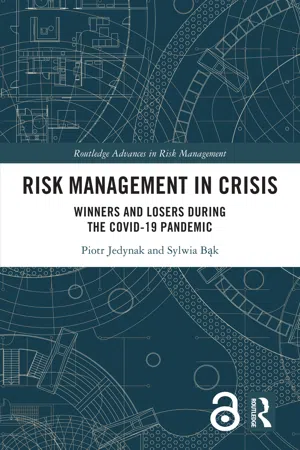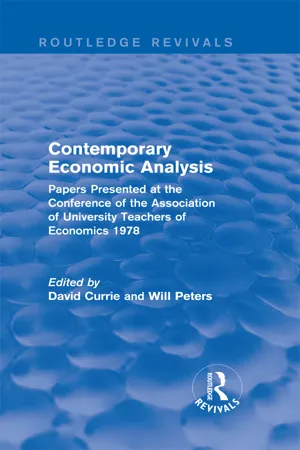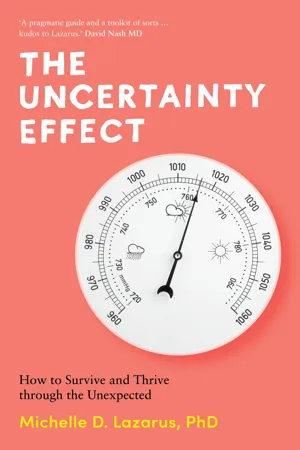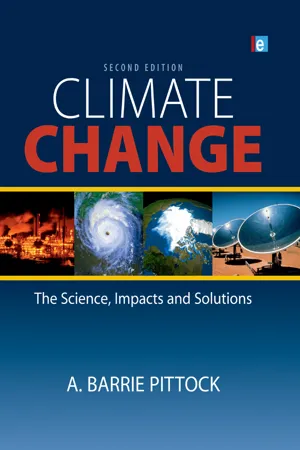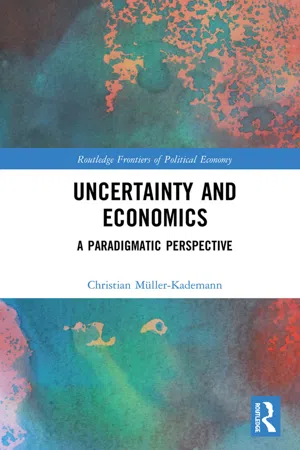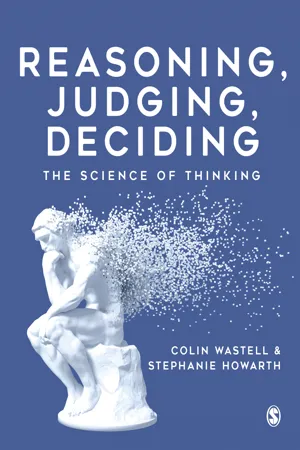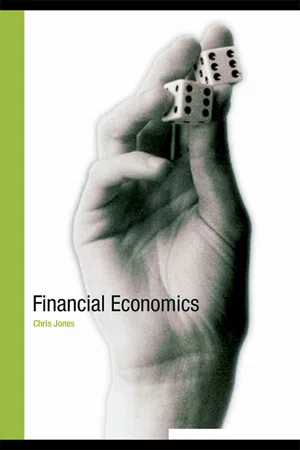Economics
Uncertainty in Economics
Uncertainty in economics refers to the unpredictable nature of future events and outcomes, which can impact decision-making and economic behavior. It encompasses various types of uncertainty, such as risk and ambiguity, and can arise from factors like incomplete information, market volatility, and unforeseen events. Economists study and analyze uncertainty to better understand its effects on markets, investment, and economic policy.
Written by Perlego with AI-assistance
Related key terms
Related key terms
1 of 4
Related key terms
1 of 3
9 Key excerpts on "Uncertainty in Economics"
- Sven Larson(Author)
- 2019(Publication Date)
- Routledge(Publisher)
1In the first section of this chapter we define uncertainty in more detail and discuss what consequences the definition has for economic analysis. Our focus is on the economic agent and her role in the dialectical process in which she has to participate to make uncertainty manageable. The relevance of incorporating uncertainty into economic analysis is stressed, asis the significance of this incorporation for how we define the economic agent and the system she is part of.Section 1.2 presents empirical results from earlier studies and adds the results of a new study. The common denominators of the studies are analyzed, as are the possible theoretical implications.Section 1.3 gives a more formal shape to the unfolding theoretical argument by suggesting how uncertainty and consumption can actually be related to each other.1.1 Uncertainty and uncertainty management
The two different interpretations of uncertainty that were mentioned above have in common that they claim the agent is unable to foresee perfectly what the future will bring to her in terms of yields on economic activities. That, however, is where the similarity stops; from hereon we shall explore the unique character of Keynesian uncertainty and its distinct axiomatic foundations in our perceptions of such fundamental properties of reality as time and space. We will also put this kind of uncertainty in relation to the alternative definition suggested by mainstream theory.First we define Keynesian uncertainty. Then we discuss what this definition implies in terms of defining the economic agent, before we can proceed with a formalized analysis.1.1.1 Time and organic interdependencyFundamentally our society stands and falls with our collective ability to handle uncertainty. In societies and economic systems that prevail, uncertainty of the Keynesian kind has been eliminated from our daily economic activities. What remains in our every day life is another kind of imperfect foresight, a kind that in literature more loyal to mainstream economics is referred to simply as uncertainty:- eBook - ePub
Risk Management in Crisis
Winners and Losers during the COVID-19 Pandemic
- Piotr Jedynak, Sylwia Bąk(Authors)
- 2021(Publication Date)
- Routledge(Publisher)
In the field of macroeconomics, research on uncertainty and risk was carried out, among others, by Fredrich von Hayek, a representative of the Austrian school. Developing the theory of decision-making, the author referred to the uncertainties of the surrounding world. He defined uncertainty as a situation in which a decision-maker has only a fragmentary part of the needed information, while the existing uncertainty can only be eliminated by the entire necessary knowledge held by a set of all decision-makers involved in a specific decision-making process. Hayek also pointed out that the market understood as a mechanism for coordinating the exchange of information can effectively deal with the phenomenon of uncertainty and the resultant dispersed knowledge (von Hayek, 1945; Brady, 2011). Uncertainty was also an important area of scientific interest for Robert Lucas Jr., who regarded it as an important element in the development of John Muth’s theory of rational expectations. Lucas analyzed prices of assets in a changing economy and developed the scientific achievements of Friedman and Phelps, whose main research focused on connections and relationships between unemployment and inflation. Lucas stressed that only uncertain changes in the supply of money can have a real impact on changes in unemployment, and the unpredictability of a monetary policy in the fight against unemployment is a factor determining its effectiveness (Lucas, 1972; 1978). Milton Friedman, on the other hand, treated risk and uncertainty as dichotomous concepts, seeing the economy as a domain of risk, not uncertainty. He also analyzed the effectiveness and consequences of choice in conditions of risk (Friedman and Savage, 1948). Another Nobel Prize winner, Franco Modigliani, is a co-author of research analyzing consumer decisions in conditions of uncertainty (Drèze and Modigliani, 1972) and, in addition, together with another Nobel Prize winner, Merton Miller, he developed a theorem on the impact of investment decisions and capital structure on the valuation of enterprises and on their ability to generate positive financial results under conditions of free competition. The assumptions for this theorem are closely linked to business risk and indicate that such risk can be estimated using the standard deviation of expected earnings before interest and tax. Thus, according to these assumptions, enterprises with the same level of standard deviation should be classified as belonging to the same risk classes (Czekaj and Dresler, 1995). William Nordhaus and Paul Romer are other Nobel Prize Laureates whose scientific work addresses the issue of risk in macroeconomics. Romer was involved in explaining interactions between economic growth and the development of innovations for which risk is one of the characteristic features (Romer, 1990). William Nordhaus, on the other hand, dealt with the impact of environmental risk on economic conditions (Nordhaus, 1993). - eBook - ePub
Contemporary Economic Analysis (Routledge Revivals)
Papers Presented at the Conference of the Association of University Teachers of Economics 1978
- David Currie, Will Peters(Authors)
- 2016(Publication Date)
- Routledge(Publisher)
Risk and UncertaintyPassage contains an image
12.Measuring Risk and Measuring Risk Aversion
J.D. Hey“What people call neutrality may simply mean indifference…”(G.K. Chesterton)1This paper2 concerned with the Economics of Uncertainty (or of Risk, the two words will be used interchangeably). In particular, it examines and appraises the basic procedure used by economists when deriving theories of behaviour under uncertainty.The usual procedure followed in the Economics of Uncertainty is as follows: a model of behaviour under certainty is taken as the starting point; one or more of the parameters of the model is then treated as random (with known probability density function). For example, in the “theory of the perfectly competitive firm under uncertainty”, models have been constructed in which the output price is random, or the input prices are random, or the production function is random. Similarly, “monopoly under uncertainty* has examined models with random demand, random input prices or randomness in the production process. The theory of “consumption under uncertainty” has considered random income streams or random interest rates. The list of possible examples extends across the whole range of economics.To begin with, the early models ignored the attitude to risk of the individual economic agents. However, later models posited a von Neumann-Morgenstern utility function, so that the individual’s attitude to risk could be explicitly considered.In such models the focus of interest is on two interrelated aspects: First, how the behaviour of the agent under uncertainty differs from that under certainty, secondly (the ‘comparative statics’), how (a) a bodily shift in the whole distribution, and (b) an increase in riskiness, affect the behaviour of the individual.An examination of the literature shows that the models can be divided into two categories: those in which unambiguous - eBook - ePub
The Uncertainty Effect
How to Survive and Thrive Through the Unexpected
- Michelle Lazarus(Author)
- 2023(Publication Date)
- Monash University Publishing(Publisher)
3 COUNTING ON UNCERTAINTY How those in economics and business can deal with the unknown‘If there’s one thing that’s certain in business, it’s uncertainty.’ — STEPHEN COVEYThroughout 2022, we endured breathless media speculation about reserve banks and boards across the developed world and their decisions around interest rates. Tension was high: will they or won’t they raise rates? How much inflation is relevant to act upon? When do cost-of-living pressures begin to bite? Experts were brought on to morning television and evening news broadcasts to discuss and debate potential rate rises. Many, including myself, tuned in, hoping for insights as we considered the ramifications of interest rate rises on our personal finances. But each broadcast panel seemed to have a different opinion – a consensus about the degree of economic uncertainty, and when it would lessen, was nowhere to be found. Viewers were left to decipher conflicting expert opinions when making choices about what to do with their household budgets. We are in unprecedented times, many experts said. Some admitted they couldn’t offer predictions based on the past because the current situation is so, well, novel.Their reluctance perhaps stemmed from the lessons of the recent past. The pandemic began with similar economic predictions from all the major players. Then, there seemed to be more certainty in the forecasts of our economic future. Experts worldwide appeared to agree that doomsday economic scenarios were the order of the day. Newspapers shouted headlines like ‘Global economy could lose 1 to 3 trillion US dollars!’ and ‘Coronavirus to lead to biggest contraction of the economy since Great Depression’. What happened instead for the next two years was, for many developed countries, a period of better-than-expected economic performance, a housing boom and an increase in consumer savings. Those who still had jobs spent their savings on household goods and products, and businesses rapidly adjusted to online trading, accelerating digital commerce exponentially ahead of prepandemic trends. We still faced a heavy, devastating death toll from Covid-19 in many places, and some of the predicted economic challenges, such as supply-chain issues and workforce deficits due to lockdowns and border closures, did come to pass. But it was only as the pandemic restrictions appeared to be easing that the most protracted economic impacts began to be felt, surprising many. - eBook - ePub
Climate Change
The Science, Impacts and Solutions
- A. Barrie Pittock(Author)
- 2013(Publication Date)
- Routledge(Publisher)
because we know that, even if the exact prediction is that it will miss us, the exact prediction is uncertain. Even a small chance of a disaster makes it worthwhile to take precautions.In a more extreme case, most of us prudently insure our house against loss by fire, even though we believe that it is very unlikely that our house will burn down. We know that the total loss of our house would be disastrous, and the premium we pay the insurance company is relatively small, so we insure against the low probability of a fire. Whether we insure depends on the relative size of the premium versus the size of the potential loss, as well as on the probability of a fire.When it comes to so-called ‘laws’ about, or predictions of human behaviour (as opposed to the behaviour of the physical world), uncertainty is usually much greater. This applies in many of the social sciences, for example economics. Economic forecasts are made based on various theories (often just simple extrapolations) of human behaviour and various assumptions. These assumptions may not hold in the future as human behaviour may change or be influenced by factors not considered.As the case of insurance demonstrates, uncertainty does not prevent decisions being made. Indeed, in any practical situation passive or active decisions are inevitably made all the time, despite uncertainty. We either decide to take out insurance, or we decide (perhaps unconsciously) not to do so. Investors and policy-makers make decisions every day despite uncertainties – they assess probabilities and risks and then make decisions, because without these decisions nothing would be done.Uncertainty in climate change projections
In any estimates of future climate change there are a number of sources of uncertainty. Some of these arise from the science itself, and some from uncertainty about future human behaviour – especially future emissions of greenhouse gases. As it happens, these two major sources of uncertainty each account for about half the total uncertainty. This is fortunate, since it means that, despite the total uncertainty, different assumptions about future human behaviour can be used to test the effect of such behaviour on climate. This can give us useful information about what sort of human behaviour is desirable to avoid the worst possible climate changes. In other words, it is useful for developing policy. - eBook - ePub
Uncertainty and Economics
A Paradigmatic Perspective
- Christian Müller-Kademann(Author)
- 2019(Publication Date)
- Routledge(Publisher)
Objective processes such as lotteries lack this reflexive-transformative aspect and must therefore not be targeted by economic policies. Consequently, research should advise what kind of problem causes an economic slump: is it resulting from a lack of confidence or from bad luck?In conclusion, the two-stage concept of decision making under uncertainty offers a range of empirical tests that may shed light on actual decision making. A reasonable set of research issues would address the validity of Keynes’s (1936) two-step view, the factors affecting the level of confidence, means for separating risk from uncertainty and general measures of confidence.The biggest advantage of the new perspective, therefore, is the opportunity to investigate human behaviour by asking open questions, that is, without having to know the “correct” answers in advance.2.4.4 Elements of an uncertainty paradigmIf one would compile a list of paradigmatic hypotheses the items subjective rationality, subjective utility maximisation, risk (ambiguity) and equilibrium (optimality, ergodicity) would certainly be considered indispensable (see 2.3.2). Since uncertainty dominates reality, replacing risk with uncertainty is imperative for economics to be, remain or become a relevant social science depending on the degree of one’s pessimism about economics’ achievements at large.Substituting risk with uncertainty will affect the paradigms of economics in more than one way. First of all, with uncertainty, economic analysis will inevitably become more empirical as it will be forced to move away from the simplistic perspective of objectively knowable event spaces implied by probability distribution functions and theory-driven equilibria. Instead of objectively defined equilibria, equilibrium must be shown to emerge - eBook - ePub
Reasoning, Judging, Deciding
The Science of Thinking
- Colin Wastell, Stephanie Howarth(Authors)
- 2021(Publication Date)
- SAGE Publications Ltd(Publisher)
The topic of uncertainty is one we have encountered before in this book. When we examined Expected Utility Theory, we discussed the question of the odds in placing a successful wager. In Prospect Theory we discovered that humans are not particularly accurate when estimating the probabilities of global events. This assertion was challenged by ecological rationality scholars such as Gerd Gigerenzer, who argued that the nature of the world we live in is far from fully predictable. It is this unpredictability that brings about a sense of uncertainty. In this chapter we want to explore a number of concepts, such as worldview defence (which we will discuss later) and uncertainty, as well as examine some of the interesting and challenging situations where uncertainty/unpredictability results in unfortunate human behaviours. The topic is vast, and we have made our selection of inclusions to challenge and broaden your understanding of the impact that uncertainty exerts on human thinking and behaviour.18.1 Uncertainty, Unpredictability, Risk and Chance
- a) The four terms that we think are in need of clarification are ‘uncertainty', ‘unpredictability', ‘risk’ and ‘chance'. These four terms are often used in similar ways and at a fundamental level share important, common, assumptions. There are, however, differences which draw our attention to their specific contexts and constraints, influencing our way of thinking. Table 18.1 provides simple definitions and illustrative examples to help clarify their distinctions.
Table 18.1The terms included in Table 18.1 draw our attention to the capriciousness of daily occurrences that can have a serious impact on our lives. From medication side effects to storm damage, our lives are populated with unpredictability. The impact of uncertainty on people's thinking has been the subject of study for many decades, and in this section we review some of the key findings from both Expected Utility Theory (EUT) and Prospect Theory. In addition to this general point, we would add the term ‘random'. Events are random if they occur with no clearly apparent reason (Macquarie Dictionary, - eBook - ePub
- John H Hoag(Author)
- 2012(Publication Date)
- WSPC(Publisher)
Chapter 13 UncertaintyKey Concepts: • Expectedvalue • Expected utility • Risk aversion • Insurance • Uncertainty for the firm • Cournot with uncertainty Goals: • Examine consumer choice with uncertainty. • See the impact of uncertainty on the firm’s choices. • Examine uncertainty in the Cournot case.Up to this time, we have assumed that the world is ruled by certainty. Suppose you are in the business of making baskets. You are thinking about adding a new stapler to your production process, but wonder if the machine will pay for itself or not. You have information from the maker of the stapler that it will last for five years with regular maintenance, and you have talked to others who use it and they agree with that assessment. Should you buy this stapler? The problem is that you cannot predict what the demand for baskets will be for the next five years to know whether the stapler will have enough use to pay for itself. How do you proceed?13.1 IntroductionWhen uncertainty arises, we have to take into consideration that the choice problem is now more complicated. There is some factor bearing on a decision that is uncertain and outside the control of the decision maker. It is pretty clear that the decision maker will not end up at the same outcome as when there is no uncertainty. In this chapter, three applications will be discussed. First, we will discuss consumer behavior in the presence of uncertainty, and follow with an application to insurance. We then turn to the firm and look at a particular aspect of choice under uncertain conditions. Finally, we look at uncertainty in the Cournot model.13.2 Consumer Choice under UncertaintyIn our previous discussion of the consumer, we assumed that the consumer acted to maximize utility subject to a budget. We would like to maintain that methodology to the extent we can. To move forward, we will consider a particular problem and see how we can use the ideas we have already developed. - eBook - ePub
- Chris Jones(Author)
- 2008(Publication Date)
- Routledge(Publisher)
3 Uncertainty and risk Consumption goods in a certainty setting are characterized by their type (physical attributes), geographic location and location in time. For example, an apple in one location is different from an apple (with the same physical attributes) in another location, and it is also different from the same apple in different time periods. Indeed, consumers derive utility from the combination of characteristics that define them, which for an apple, include sweetness, size, colour, firmness and moisture content. In fact, it is possible to estimate the price of any good as the summed value of its characteristics using hedonic prices, which are consumer marginal valuations for each characteristic. 1 Uncertainty introduces randomness into future consumption through exogenous variability in the environment within which consumers live. Its effects may be confined to the variance it imparts to their consumption or a combination of that and its direct impact on their utility. Debreu (1959) captures uncertainty by expanding the characteristics used to define consumption goods by making them state-contingent, where all possible future states of the world are defined by unique combinations of a set of environmental variables. Consumers choose future consumption bundles that are contingent upon the realization of a final state of the world. In effect, they pre-commit to trades in specified states, where uncertainty is resolved when the true state eventuates. 2 This is the state-preference approach to uncertainty that extends a standard certainty analysis by expanding the commodity space to include goods that are state-contingent
Index pages curate the most relevant extracts from our library of academic textbooks. They’ve been created using an in-house natural language model (NLM), each adding context and meaning to key research topics.
Explore more topic indexes
Explore more topic indexes
1 of 6
Explore more topic indexes
1 of 4

